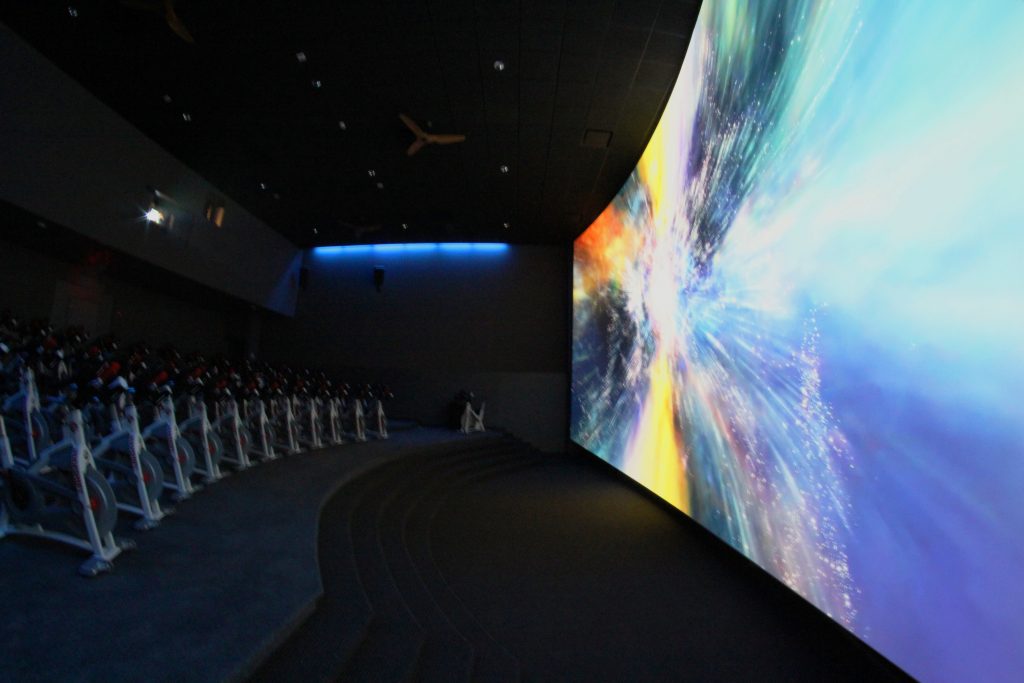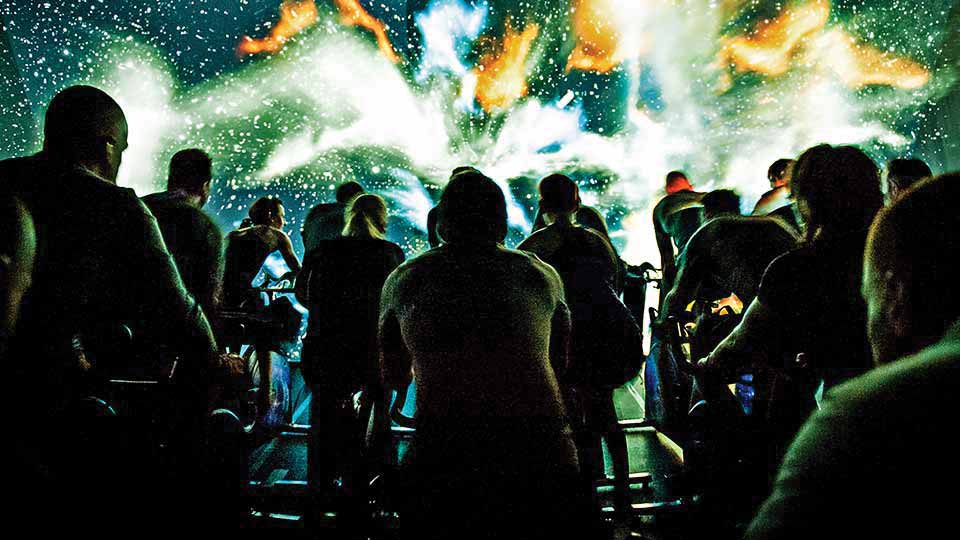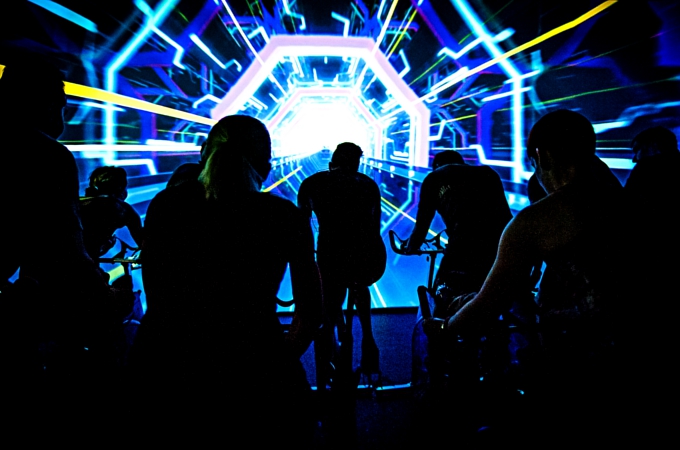Could Immersive Fitness Be the Cure for Obesity?
Posted by Sasha Bailyn on Friday, June 24th, 2016
Just thinking about exercising in a gym is enough to send many Americans back to the couch. From a weird competitive culture that doesn’t fit a lot of people’s ideas of fun or getting healthy to the simple reality of sterile cardio machines, gyms simply don’t get people excited about getting fit. Think of spin classes, where you’re riding a bike as hard as you can pedal while staring at a blank wall or your own image in the mirror. Over the past 30 years, obesity in America has doubled in children and has increased by 400% in adolescents. One reason why many people dislike exercise is because they get bored. Immersive fitness experiences are taking some of the best techniques that exist in experience design and using that to change up the exercise experience.
Fighting obesity in America means thinking outside of the box. Developing ways to keep people entertained and engaged, will keep them exercising—whether they are aware of it or not. Immersive fitness experiences are one strategy to get people excited. IMAX recently announced the launch of their IMAXShift brand, which is starting with a test studio in New York City. According to the announcement, “IMAXShift will reinvent the indoor cycling experience by offering an immersive, thrilling and effective workout, led by some of the industry’s most acclaimed instructors and powered by IMAX’s cinema-grade projection and sound technology. The purpose-built studio, which will accommodate up to 50 riders at a time, features IMAX’s patented theatre geometry and combines heart-pounding, crystal-clear audio and sharp, hyper-real imagery on the legendary giant IMAX screen to completely immerse riders in a full sensory workout experience.”
Much like a virtual reality experience, immersive fitness combines video, music, and exercise to help transport people working out to another world. Immersive classes function as a total escape from a regular gym experience. A full sensory workout can create a heightened sense of anticipation as participants “ride” through fantastic landscapes like outer space or dream-like scenarios. By suspending belief, people are thinking less about the workout, as they push themselves further through the experience. There are three main components to an immersive fitness experience:
Visual: During this unique workout, content projects onto cinema-scale screens. With the Imax experience, the images wrap around exercisers to ensure that the effect is full-scale. Whether they’re scaling a remote alpine pass or soaring over the shores of Hawaii, participants have a 360-degree view of crisp and stimulating images to visually engulf them. The video content synchronizes with the music and exercise, and in some cases, the instructor as well. Although instructors still run the class, a participant’s vision and focus is on the images designed for the complete experience.

Audio: A combination of sounds go into creating immersive fitness, which includes music and live instruction. Like a movie theater, speakers are carefully positioned to draw people in. The music is always in sync with all other actions going on, and is perfectly timed for various levels of difficulty during the workout. Video concepts based on music concerts, and much like a cinematic score, everything links together. Instructors guide the routines, without interrupting the experience.
Exercise: Although the majority of these programs are set for a cycling activity, they are now expanding, as many gyms are using the specially designed studios for other regularly scheduled classes. Some studios that have begun incorporating immersive experiences, have seen as much as a 25% increase in attendance. Clearly, there has been a growing consumer demand for more engaging exercise experiences, and immersive fitness is meeting it.

What does the future look like for immersive fitness and could this be an important market for innovative designers? Les Mills is one of the founding companies of the immersive experience, and offers it in nine equipped studios with two currently in the United States (New York, NY, and Santa Monica, CA). So far they have created six separate “Trips,” each with unique content. The programs offer various experiences, with titles like “Down the Rabbit Hole,” “Gravitate,” and “Metropolis.”
IMAX is the latest to pick up on the trend, as their pilot IMAXShift moves into the immersive fitness space. IMAX has committed to the initial studio in Brooklyn, which is well-known as being a community of artists and early adopters and also fits the key demographic, to enable it to assess the concept’s commercial viability. If successful, the companies says that they plan to employ a licensing approach similar to the one with which it has so successfully structured its global theatre network.
What does this mean for entertainment designers? The first question that comes to mind is whether there are opportunities beyond spinning. It’s a natural place to start. Could yoga be enhanced with a virtual reality headset that shows soothing images or could AI and biofeedback technology help turn a routine stairclimb workout into a virtual scaling of Mount Everest? Yet designers who find ways to incorporate experience design into a wider range of fitness options will be the most successful.

Virtual reality is opening up a range of new options for people who want to replicate different experiences using headsets like Google Cardboard or Samsung VR, for example. Widerun is an app that lets stationary bike riders have a more dynamic experience, for example. Applications for treadmills and ellipticals are compelling, although there are safety considerations at play.
For entertainment designers, there are questions around more than just “what activities can this be applied to?” Once you’ve sorted out the question of a gym experience versus a personal tool, there are other layers. What could be done to make this experience more compelling? Could gamification elements help get people excited about exercise and looking forward to participating? In there a way to link the explosion of today’s fitness monitors to more compelling immersive experiences? Given the multi-billion dollar fitness industry, it seems to be an area that’s ripe for innovation but we’re just seeing the first ripples in the space.
The fight against obesity has been a challenging one. Studies in the field have led to new data that better prepares society for battling this epidemic. One of those manifestations has been interactive fitness. It’s a means of addressing boredom with exercise. By thoroughly engaging participants in an immersive experience, people tend to forget they’re exercising at all – and that seems to be the first step to getting Americans moving again.
Images sourced courtesy of IMAXShift and Les Mills



 Sign Up For Our Newsletter
Sign Up For Our Newsletter 



